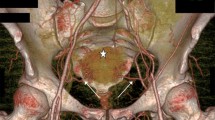Abstract
Purpose
The median sacral artery (MSA) is the termination of the dorsal aorta, which undergoes a complex regression and remodeling process during embryo and fetal development. The MSA contributes to the pelvic vascularization and may be injured during pelvic surgery. The embryological steps of MSA development, anastomosis formation and anatomical variations are linked, but not fully understood.
Methods
The pelvic vascularization and more precisely the MSA of a human fetus at 22 weeks of gestation (GW) were studied using micro-CT imaging. Image treatment included arterial segmentations and 3D visualization.
Results
At 22 GW, the MSA was a well-developed straight artery in front of the sacrum and was longer than the abdominal aorta. Anastomoses between the MSA and the internal pudendal arteries and the superior rectal artery were detected. No evidence was found for the existence of a coccygeal glomus with arteriovenous anastomosis.
Conclusions
Micro-CT imaging and 3D visualization helped us understand the MSA central role in pelvic vascularization through the ilio-aortic anastomotic system. It is essential to know this anastomotic network to treat pathological conditions, such as sacrococcygeal teratomas and parasitic ischiopagus twins (for instance, fetus in fetu and twin-reversed arterial perfusion sequence).





Similar content being viewed by others
References
Sato Y (2013) Dorsal aorta formation: Separate origins, lateral-to-medial migration, and remodeling. Dev Growth Differ 55:113–129. https://doi.org/10.1111/dgd.12010
Pearl MS, Gest TR, Gailloud P (2014) Superior rectal artery origin from the median sacral artery–angiographic appearance, developmental anatomy, and clinical implications. Clin Anat 27:900–905. https://doi.org/10.1002/ca.22370
Thomson A (1893) Third annual report of committee of collective investigation of Anatomical Society of Great Britain and Ireland for the Year 1891-92. J Anat Physiol 27: 183–194
Angel CA, Murillo C, Mayhew J (1998) Experience with vascular control before excision of giant, highly vascular sacrococcygeal teratomas in neonates. JPediatrSurg 33:1840–1842
Lukish JR, Powell DM (2004) Laparoscopic ligation of the median sacral artery before resection of a sacrococcygeal teratoma. J Pediatr Surg 39:1288–1290. https://doi.org/10.1016/j.jpedsurg.2004.04.042
Jin Z, Cho K, Jang HS, Murakami G, Azquez I (2016) Median sacral artery, sympathetic nerves, and the coccygeal body: a study using serial sections of human embryos and fetuses. Anat Rec 827:819–827. https://doi.org/10.1002/ar.23365
Fritsch H (1988) Developmental changes in the retrorectal region of the human fetus. Anat Embryol (Berl) 177:513–522
Saitsu H, Yamada S, Uwabe C, Ishibashi M, Shiota K (2004) Development of the posterior neural tube in human embryos. Anat Embryol (Berl) 209:107–117. https://doi.org/10.1007/s00429-004-0421-2
Sae-jung S, Khamanarong K, Woraputtaporn W, Amarttayak P (2015) Awareness of the median sacral artery during lumbosacral spinal surgery: an anatomic cadaveric study of its relationship to the lumbosacral spine. Eur Spine J 24:2520–2524. https://doi.org/10.1007/s00586-014-3641-z
Zilberlicht A, Molnar R, Pal-ohana H, Haya N, Auslender R (2016) Characterization of the median sacral artery course at the sacral promontory using contrast-enhanced computed tomography. Int Urogynecol J. 28(1):101–104. https://doi.org/10.1007/s00192-016-3074-9
Gray H (1918) Anatomy of the Human Body
Testut L (1899) Traité d’anatomie humaine. Tome 2. Angéiologie
Kara E, Altan Y, Nail Â, Öztürk C (2008) An extremely rare bifurcation pattern of the caudal abdominal aorta: case report demonstrated by angiography. 30:689–691. https://doi.org/10.1007/s00276-008-0389-3
Glodny B, Henninger B, Hofmann K, Trieb T, Petersen J, Rehder P (2009) CT appearance of a patent impar umbilical artery in an adult woman and related anomalies: a case report and review of the literature. Cases J 2:65. https://doi.org/10.1186/1757-1626-2-65
Chenin L, Tandabany S, Foulon P, Havet E, Peltier J (2017) A median sacral artery anterior to the iliocaval junction: a case report—anatomical considerations and clinical relevance for spine surgery. Surg Radiol Anat. 40(1):115–117. https://doi.org/10.1007/s00276-017-1917-9
Kamina P (2005) Précis d’anatomie clinique. Maloine 4(9):115–117. https://doi.org/10.1002/uog.13272
Szolar DH, Preidler KW, Steiner H, Riepl T, Flaschka G, Stiskal M, Moelleken S, Norman D (1996) Vascular complications in lumbar disk surgery: report of four cases. Neuroradiology 38:521–525
Altman R, Randolph J, Lilly J (1974) Sacrococcygeal teratoma: American Academy of Pediatrics Surgical Section Survey 1973. J Pediatr Surg 9 9:389–398
Van Mieghem T, Al-Ibrahim A, Deprest J, Lewi L, Langer JC, Baud D, O’Brien K, Beecroft R, Chaturvedi R, Jaeggi E, Fish J, Ryan G (2014) Minimally invasive therapy for fetal sacrococcygeal teratoma: Case series and systematic review of the literature. Ultrasound Obstet Gynecol 43:611–619. https://doi.org/10.1002/uog.13315
Spencer R (2001) Parasitic conjoined twins: external, internal (Fetuses Fetu and Teratomas), and Detached (Acardiacs). Clin Anat. 444: 428–444
Lee EYC (1965) Foetus in foetu. Arch Dis Childh 40:689–693
Price B (1950) Primary biases in twin studies; a review of prenatal and natal difference-producing factors in monozygotic pairs. Am J Hum Genet 2:293–352
Acknowledgements
We would like to thank Gérard Subsol for review of the Methods section. Data used in this study were partly produced thanks to the equipment of the MRI facility and the labEx CeMEB.
Author information
Authors and Affiliations
Contributions
P.M. data management, data analysis, manuscript writing, A.B. data analysis, A.R.C manuscript writing, H.L. data analysis, G.C. project development, data collection, data analysis, manuscript writing.
Corresponding author
Ethics declarations
Conflict of interest
All the authors declare that they have no conflict of interest.
Rights and permissions
About this article
Cite this article
Meignan, P., Binet, A., Cook, A.R. et al. Fetal median sacral artery anatomy study by micro-CT imaging. Surg Radiol Anat 40, 735–741 (2018). https://doi.org/10.1007/s00276-018-2032-2
Received:
Accepted:
Published:
Issue Date:
DOI: https://doi.org/10.1007/s00276-018-2032-2




